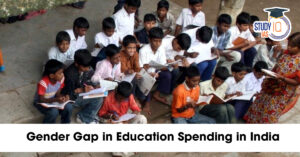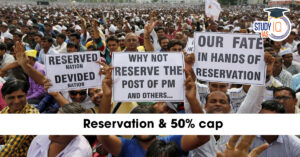Table of Contents
Context: Recently, Prime Minister Narendra Modi, in his ‘Mann Ki Baat’ radio programme, highlighted the alarming increase in obesity in India. The National Family Health Survey Round 5 (NFHS-5, 2019-21) suggests that nearly one in every four men or women is obese.
More in News
- He cited that 1 in 8 Indians is affected by obesity.
- Urged people to reduce oil consumption by 10% per month to promote a healthier lifestyle.
Obesity Challenge: The Scale of the Problem
Definition of Obesity: The World Health Organization (WHO) defines overweight and obesity as abnormal or excessive fat accumulation that poses a health risk.
Obesity Trends in India (NFHS Data)
The National Family Health Surveys (NFHS) data shows a steady rise in obesity:
- Women (Overweight/Obese):
- 2015-16 (NFHS-4): 6%
- 2019-21 (NFHS-5): 24%
- Men (Overweight/Obese):
- 2015-16 (NFHS-4): 9%
- 2019-21 (NFHS-5): 9%
- Urban obesity levels are significantly higher than rural areas.
Abdominal Obesity (Lancet Study, 2023)
A 2023 study in The Lancet Regional Health Southeast Asia analyzed NFHS-5 data and found:
- 40% of women had abdominal obesity.
- 12% of men had abdominal obesity.
Childhood Obesity
NFHS data shows an increase in overweight children under 5 years:
- 2015-16: 2.1%
- 2019-21: 3.4%
- Older children face even higher risks (World Obesity Atlas 2022 estimates for 2030):
- 5 to 9-year-olds: 81% prevalence
- 10 to 19-year-olds: 23% prevalence
Health Risks Associated with Obesity
Metabolic Syndrome
Indians are genetically predisposed to storing fat in the abdomen.
- Abdominal obesity contributes to metabolic syndrome, increasing risks of:
- Type 2 diabetes
- Heart disease
- Stroke
Adult Health Risks
According to the WHO, obesity is a major risk factor for leading causes of poor health and early death, including:
- Several types of cancer
- Osteoarthritis
Diabetes
India has the highest number of diabetes cases in the world, with 101 million people suffering from diabetes.
Cancer
Indian Council of Medical Research (ICMR) – National Cancer Registry Programme projects:
- 2022: 14.6 lakh cases
- 2025: 15.7 lakh cases
Cardiovascular Diseases (CVDs)
- One of the leading causes of death and disability in India.
- Indians are affected by CVDs at least 10 years earlier than other populations.
Non-Communicable Diseases (NCDs)
60% of all deaths in India are now due to NCDs, which include obesity-related illnesses.
Childhood and Adolescent Health Risks
Childhood obesity can lead to:
- Higher risk of NCDs at an earlier age.
- Adverse psychosocial effects:
- Lower school performance.
- Lower quality of life.
- Higher risk of stigma, discrimination, and bullying.
- Children with obesity are more likely to remain obese in adulthood.
Causes of Rising Obesity in India
Unhealthy Diet and Ultra-Processed Foods
Urban India has seen a rise in:
- Ultra-processed food consumption.
- Unhealthy eating habits (high in sugar, salt, and unhealthy fats).
Low Physical Activity Levels
A Lancet Global Health Study (2023) found that:
- Nearly 50% of Indians do not get sufficient physical activity.
- Indoor lifestyle: Increased use of digital devices and sedentary work culture.
- Outdoor conditions discourage activity:
- No safe cycling lanes or pedestrian paths.
- Shrinking green spaces.
- Rising street crime deters walking in urban areas.
Air Pollution
Air pollution contributes to inflammation, leading to:
- Increased risk of cardio-metabolic diseases.
- Visceral fat accumulation (fat stored around organs).
Economic Barriers to Healthy Eating
- Low-income households rely on carbohydrate-heavy diets (rice & wheat).
- Protein & micronutrient-rich foods (fruits, vegetables, dairy, pulses, meat) are expensive.
- Rural obesity is rising and may soon overtake urban obesity.
Limitations in Measuring Obesity
- Traditional BMI Limitations: Body Mass Index (BMI) is the most commonly used metric but has limitations:
- Does not differentiate between muscle mass and fat.
- Does not indicate fat distribution in the body.
Updated Obesity Diagnosis Guidelines
- Indian experts introduced a new obesity classification:
- Stage 1: Increased fat accumulation but no impact on organs or daily life.
- Stage 2: Fat accumulation impacts organ function and physical abilities.
- Recommended new measurement methods:
- Waist circumference
- Waist-to-height ratio
- Body fat percentage
Current Situation of Obesity and Related Diseases in India
- Obesity Rates: Increased from 1.2% in 1990 to 9.8% in 2022 for women and from 0.5% to 5.4% for men.
- Prevalence of Overweight/Obesity: 9% among men and 24% among women in NFHS-5.
- Abdominal Obesity: 40% of women and 12% of men are abdominally obese.
- Childhood Obesity: A 60% increase in prevalence among under-five children between NFHS-4 and NFHS-5.
Associated Health Risks
- Diabetes: 1 in 4 Indian adults is diabetic or prediabetic.
- Cardiovascular diseases: Obesity contributes to hypertension and heart-related ailments.
- Liver disorders: High-fat diets and obesity lead to fatty liver disease.
- Economic burden: Obesity-related costs amounted to $28.95 billion in 2019 (1.02% of GDP), expected to rise to 57% of GDP by 2030.
Government Shortcomings
- Lack of Targeted Programs: While undernutrition is a focus of government programs, obesity is not adequately addressed through structured policies.
- Initiatives like Khelo India, Fit India Movement, and Eat Right India put the burden of action solely on individuals, ignoring systemic issues.
- Inadequate Regulation on Processed Foods: Ultra-processed foods (UPF) and high-fat, salt, and sugar (HFSS) foods are widely available and aggressively marketed.
- There is no strong policy to tax junk food or regulate misleading food advertisements.
- Lack of Urban Planning for Physical Activity: Most cities lack cycling tracks, pedestrian-friendly roads, and open gyms for public use.
- Sedentary lifestyles are increasing due to poor infrastructure and lack of accessible recreational spaces.
- Health System Gaps: Doctors rarely check for obesity or discuss healthy weight during routine consultations.
- No national protocol for obesity management through clinical interventions, medications, or counseling.
- Food Affordability and Nutrition Gap: Healthy food is more expensive than junk food in India.
- According to the 2024 State of Food Security and Nutrition Report, 55% of Indians cannot afford a healthy diet.
What Needs to be Done?
- Public Awareness and Science Communication: Obesity must be recognized as a chronic disease, not just a lifestyle issue.
- Nationwide awareness campaigns should focus on the risks of obesity and the benefits of healthy eating.
- Better Urban Planning for Physical Activity: Create dedicated walking and cycling lanes in cities.
- Ensure open gyms, public parks, and exercise-friendly spaces are available and accessible.
- Taxation on Junk Food & Subsidies for Healthy Food: Higher taxes on ultra-processed foods and sugar-laden beverages.
- Subsidies on fruits, vegetables, and other nutritious food to make them affordable for all.
- Routine Screening & Medical Interventions: Mandatory weight, height, and waist circumference measurements during health check-ups.
- Clear guidelines for prescribing anti-obesity medications and interventions.
- School and Workplace Initiatives: Schools should promote healthy eating habits, restrict unhealthy foods in canteens, and introduce nutrition education.
- Workplaces should provide regular health screenings and promote active lifestyles.
- Inter-Ministerial Coordination: A multi-sectoral task force (Health, Finance, Education, Urban Development, and Agriculture ministries) should lead India’s obesity control strategy.
- Food Industry Regulation: Stringent advertising regulations on HFSS foods, especially those targeting children.
- Online food delivery platforms should promote healthy choices.


 Geo-tagging of Buildings During Upcoming...
Geo-tagging of Buildings During Upcoming...
 Gender Gap in Educational Expenditure in...
Gender Gap in Educational Expenditure in...
 Reservation and 50% Cap: Constitutional ...
Reservation and 50% Cap: Constitutional ...

























